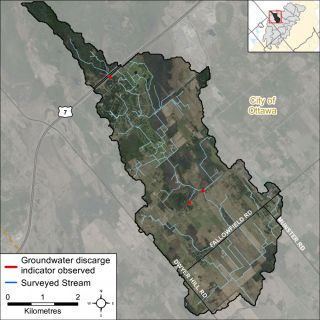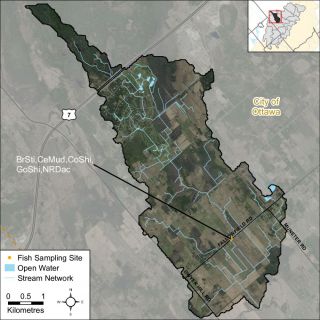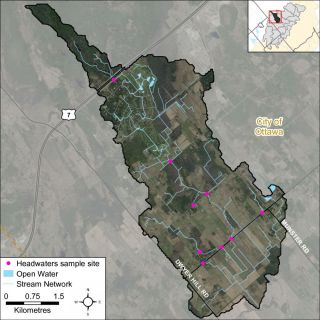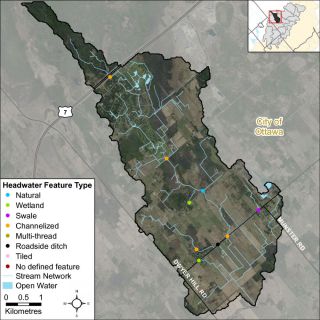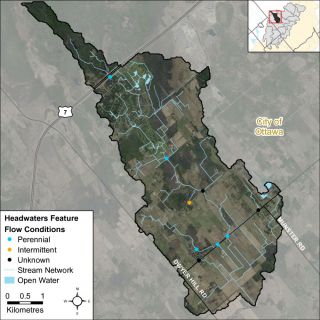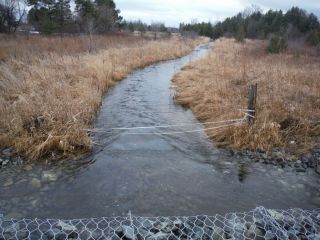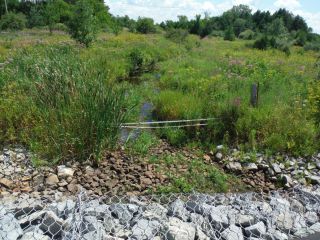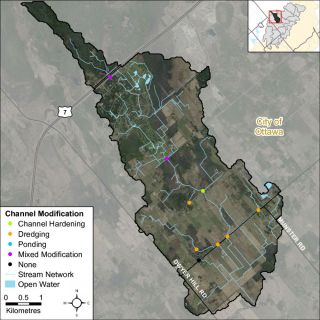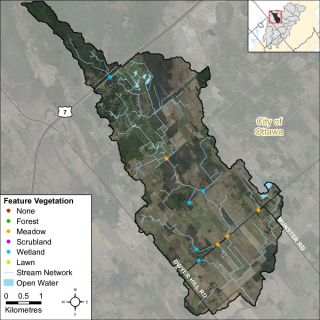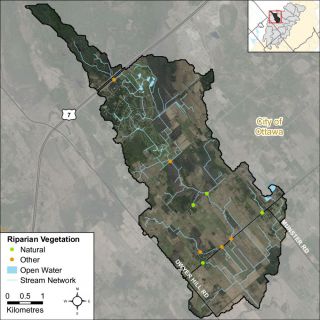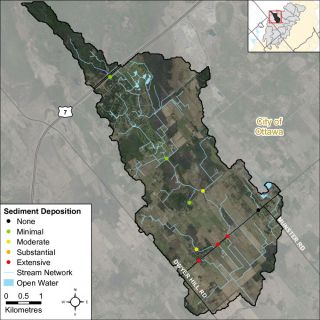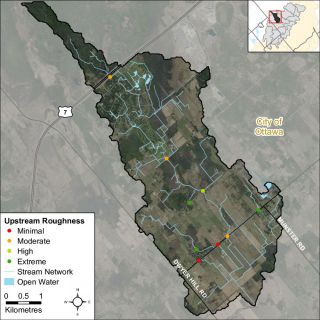2.0 Jenkinson Drain Catchment: Riparian Conditions
2.1 Jenkinson Drain Instream Aquatic Habitat
2.1.1 Groundwater
Groundwater discharge areas can influence stream temperature, contribute nutrients, and provide important stream habitat for fish and other biota. During headwater surveys, indicators of groundwater discharge are noted when observed. Indicators include: springs/seeps, watercress, iron staining, significant temperature change and rainbow mineral film. Figure 2 shows areas where one or more of the above groundwater indicators were observed during headwater assessments.
2.1.2 Fish Community
The Jenkinson Drain catchment is classified as a mixed community of warm and cool water baitfish fishery with 5 species observed. Figure 3 shows the sampling locations in the Jenkinson Drain catchment.
The following table contains a list of species observed in the watershed.
| Fish Species | Fish code |
|---|---|
| brook stickleback | BrSti |
| central mudminnow | CeMud |
| common shiner | CoShi |
| golden shiner | GoShi |
| northern redbelly dace | NRDac |
2.2 Jenkinson Drain Headwater Drainage Features Assessment
2.2.1 Headwater Sampling Locations
The RVCA Stream Characterization program assessed Headwater Drainage Features for the Jock River subwatershed in 2015. This protocol measures zero, first and second order headwater drainage features (HDF). It is a rapid assessment method characterizing the amount of water, sediment transport, and storage capacity within headwater drainage features (HDF). RVCA is working with other Conservation Authorities and the Ministry of Natural Resources and Forestry to implement the protocol with the goal of providing standard datasets to support science development and monitoring of headwater drainage features. An HDF is a depression in the land that conveys surface flow. Additionally, this module provides a means of characterizing the connectivity, form and unique features associated with each HDF (OSAP Protocol, 2013). In 2015 the program sampled 9 sites at road crossings in the Jenkinson Drain catchment area (Figure 4).
2.2.2 Headwater Feature Type
The headwater sampling protocol assesses the feature type in order to understand the function of each feature. The evaluation includes the following classifications: defined natural channel, channelized or constrained, multi-thread, no defined feature, tiled, wetland, swale, roadside ditch and pond outlet. By assessing the values associated with the headwater drainage features in the catchment area we can understand the ecosystem services that they provide to the watershed in the form of hydrology, sediment transport, and aquatic and terrestrial functions. Four features were classified as having been channelized, one was classified as a road side ditch, two were dominated by wetland, one swale and one feature was identified as natural. Figure 5 shows the feature type of the primary feature at the sampling locations.
2.2.3 Headwater Feature Flow
The observed flow condition within headwater drainage features can be highly variable depending on timing relative to the spring freshet, recent rainfall, soil moisture, etc. Flow conditions are assessed in the spring and in the summer to determine if features are perennial and flow year round, if they are intermittent and dry up during the summer months or if they are ephemeral systems that do not flow regularly and generally respond to specific rainstorm events or snowmelt. Flow conditions in headwater systems can change from year to year depending on local precipitation patterns. Figure 6 shows the observed flow conditions at the sampling locations in the Jenkinson Drain catchment in 2015.
2.3.4 Headwater Feature Channel Modifications
Channel modifications were assessed at each headwater drainage feature sampling location. Modifications include dredging, channel hardening and mixed modifications. The Jenkinson Drain catchment area had one site classified as having no channel modifications, one features were classified as being hardened, five features had been dredged and two had mixed modifications. Figure 7 shows the channel modifications observed at the sampling locations for Jenkinson Drain.
2.3.5 Headwater Feature Vegetation
Headwater feature vegetation evaluates the type of vegetation that is found within the drainage feature. The type of vegetated within the channel influences the aquatic and terrestrial ecosystem values that the feature provides. For some types of headwater features the vegetation within the feature plays a very important role in flow and sediment movement and provides fish and wildlife habitat. The following classifications are evaluated no vegetation, lawn, wetland, meadow, scrubland and forest. The features assessed in the Jenkinson Drain catchment were classified being dominated by wetland and meadow vegetation. Figure 8 depicts the dominant vegetation observed at the sampled headwater sites in the Jenkinson Drain catchment.
2.3.6 Headwater Feature Riparian Vegetation
Headwater riparian vegetation evaluates the type of vegetation that is found along the adjacent lands of a headwater drainage feature. The type of vegetation within the riparian corridor influences the aquatic and terrestrial ecosystem values that the feature provides to the watershed. Four sample locations in Jenkinson Drain were dominated by natural vegetation in the form of scrubland, meadow and wetland vegetation. Five sample locations were dominated by other forms of vegetation of either crops or ornamental grasses. Figure 9 depicts the type of riparian vegetation observed at the sampled headwater sites in the Jenkinson Drain catchment.
2.3.7 Headwater Feature Sediment Deposition
Assessing the amount of recent sediment deposited in a channel provides an index of the degree to which the feature could be transporting sediment to downstream reaches (OSAP, 2013). Evidence of excessive sediment deposition might indicate the requirement to follow up with more detailed targeted assessments upstream of the site location to identify potential best management practices to be implemented. Conditions ranged from no deposition observed to extensive deposition recorded. Figure 10 depicts the degree of sediment deposition observed at the sampled headwater sites in the Jenkinson Drain catchment.
2.3.8 Headwater Feature Upstream Roughness
Feature roughness will provide a measure of the amount of materials within the bankfull channel that could slow down the velocity of water flowing within the headwater feature (OSAP, 2013). Materials on the channel bottom that provide roughness include vegetation, woody debris and boulders/cobble substrates. Roughness can provide benefits in mitigating downstream erosion on the headwater drainage feature and the receiving watercourse by reducing velocities. Roughness also provides important habitat conditions for aquatic organisms. The sample locations in the Jenkinson Drain catchment area ranged from minimal to extreme roughness conditions. Figure 11 shows the feature roughness conditions at the sampling locations in the Jenkinson Drain catchment.
